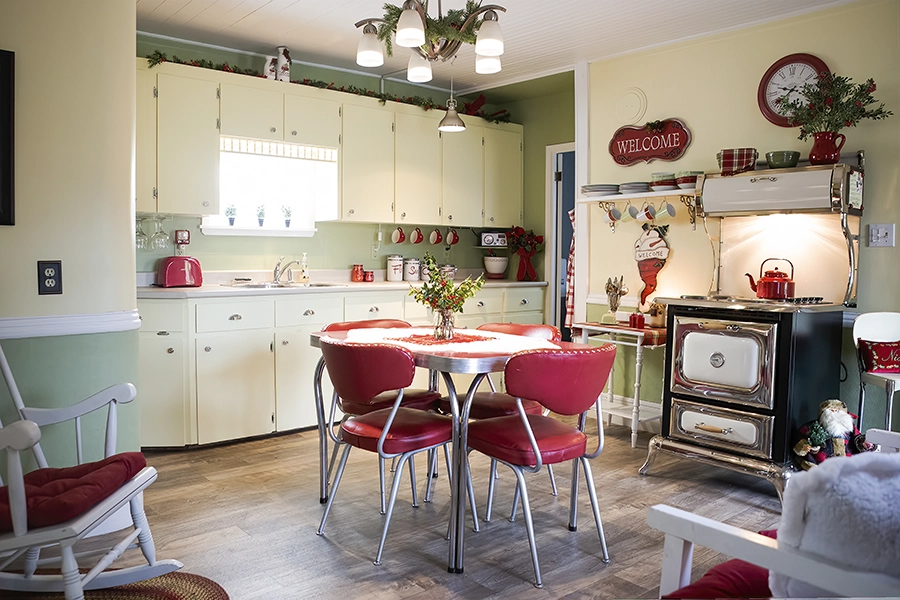Kimberley Eddy, a Bedford, N.S., artist and former interior decorator, says seascapes nourish her soul. “I have sand collections, shell collections, sea glass collections gathered at different beaches throughout the years,” she says. “Generally, we collect these things not just because they look pretty, but because we feel a connection to them. They help to define us and to ground us.”
The coast also inspires Eddy’s art; most of her work conveys coastal themes. Just as the ocean can seem to have a transient temperament, say brooding, calm, angry, spirited, Eddy hopes to convey an energy in her art, evoking a memory or an emotional response.
Decorating your home is an opportunity to express your personal style and create a space that feels comfortable. Having a connection to the art that surrounds you reflects “who you are and tells part of your story,” says Eddy.
Damien Packwood, an interior designer and owner of Damien Morris Designs in Charlottetown, says he mounted oars on his son’s bedroom wall to remind him of their Newfoundland roots. “That’s part of our story,” he says.
Packwood is attentive to how people describe individual style. Sometimes they know what they don’t like, he says, but aren’t sure what they like. “I go in with fresh eyes,” he says. “I may see patterns they don’t see over time.” Plus, he notes, your style can evolve over time.
Once he has some details, Packwood uses virtual-reality glasses to expand on styles and ideas, bringing them to life. “If I have measurements and images of a space, I can create the whole environment for you to see beforehand, looking through the VR glasses,” he says.
In some instances, a singular piece of art can overpower a space. Packwood says a client recently asked him to reconfigure her blue sunroom. “I ask, what’s the function of the room, what do you want the feel to be, is there anything that’s staying here that I need to work with,” he says.
She wanted to keep a 75-cm-by-150-cm painting featuring blacks, reds, and yellows. Each colour represented an aspect of native spirituality from the artist’s past. Packwood had to make it work.
“We have to think about light, blinds, temperature, these types of things… but also colour, since this piece is quite dramatic,” Packwood says.
Still, there’s room for a measured, eclectic approach. “I want things to tie in, but I don’t want the room to look too matchy matchy, like I’ve totally based its colours around that one painting. Then it looks staged.”
One of the room’s walls was white; the painting now resides on its centre, buffeted by lots of space. “Some of its colours are repeated in throw cushions, so there’s some cohesion throughout the room,” says Packwood.
Likewise, Eddy says that overly colour coordinated rooms tend to resemble a showroom.
“Ideally it would look more like you’ve collected décor items and art over time, where each piece has a story, instead of the story being that this room goes together.”
“Art can be freeing in as much as it can give people license to do what makes them happy, what they connect with or what they feel they need,” says Eddy.
She suggests homeowners pick three words to describe how they want to feel when they walk into a room. Calm, sanctuary, and safe suggest an emphasis on whites and blues, colours known to lower your heart rate. She suggests accessorizing with soothing images, a cozy comforter, and plush pillows.
Local art adds a dimension, too, Eddy notes. The draw is that it’s original, it has soul, depth, and meaning. “As artists we create works out of passion and love for where we live, translating that into expressions of style and culture, history and connectedness.”
“Ultimately, I put my heart and soul out there on the canvas. When people are standing in front of my work, looking at the waves, I hope they actually feel something visceral; that they can imagine how the waves sound lapping on the shore.”
5 WAYS TO HONE YOUR PERSONAL STYLE
-
- Mix and match textures, sizes, and heights to provide depth and personality.
- Declutter after the holidays. “When I store my Christmas decorations in January, I put back the regular stuff slowly,” Packwood says. “The empty spaces can afford clarity and inspiration.”
- Create the art you want. “I recently saw a navy painting with gold geometric patterns that I fell in love with, but there was no way it was coming home with me,” says Packwood. “So I recreated it on a wall in my office.”
- Rotate art on a regular basis. To reconfigure her sideboard art display, Eddy says she’ll take everything away, then start from scratch, tweaking and adding pieces as she goes.
- Browse art school and amateur galleries to learn what kind of art appeals to you (and find a deal on a brilliant, unknown artist’s work).


.jpg)

















